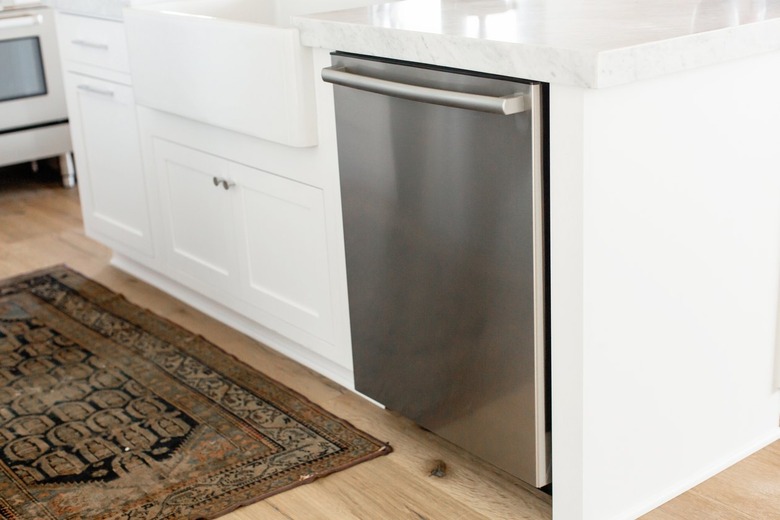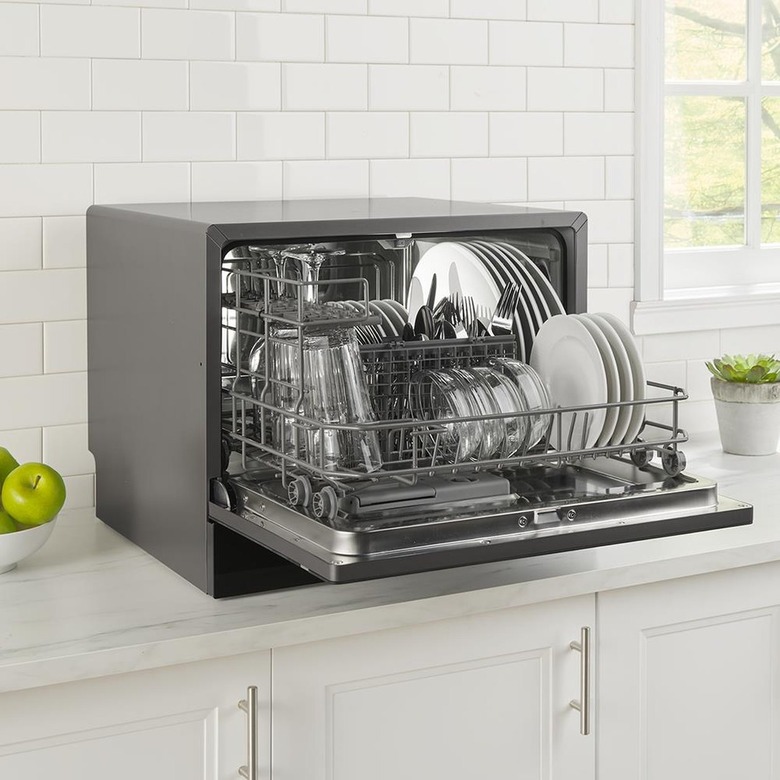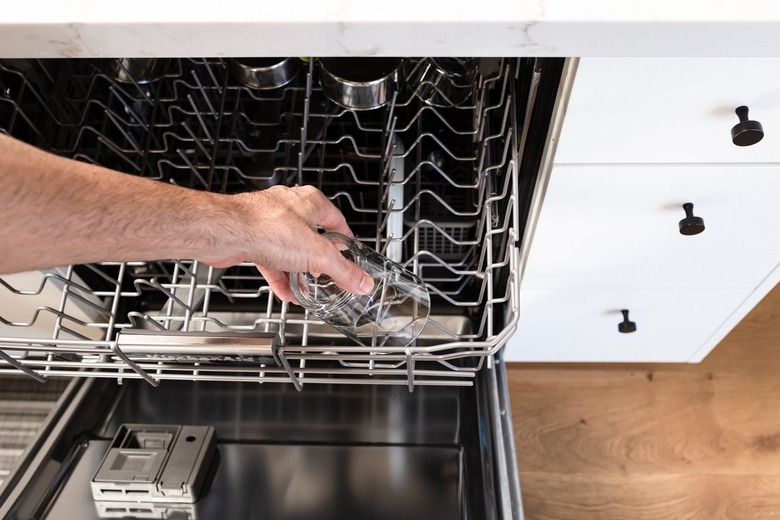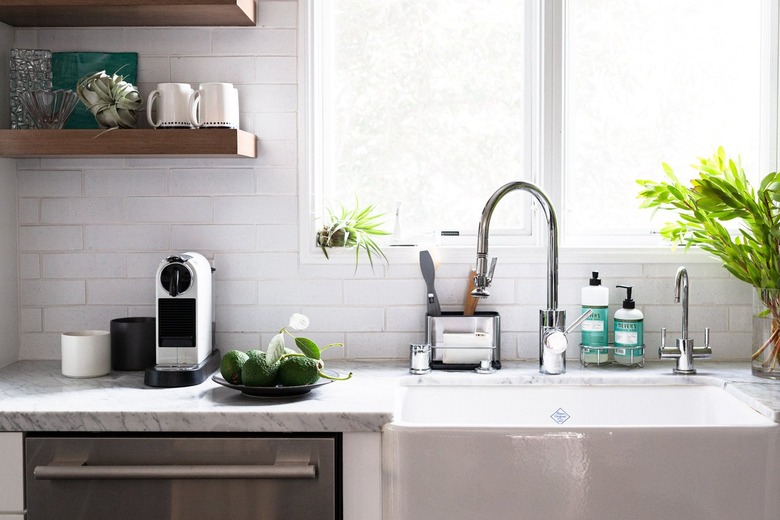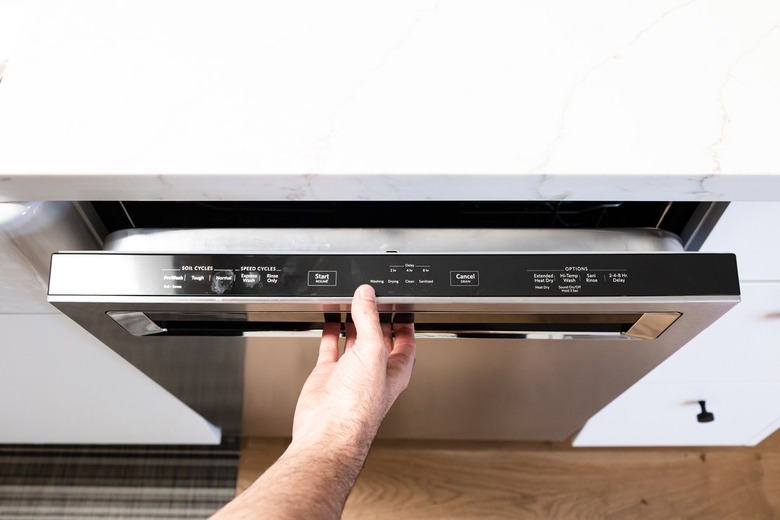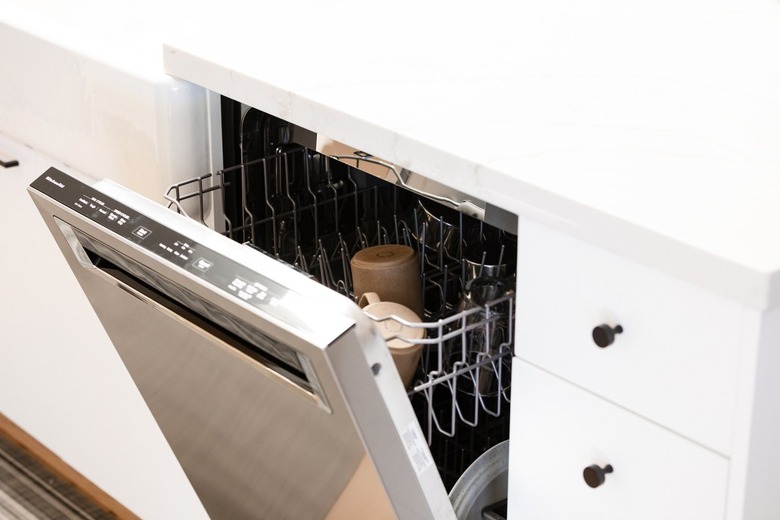How To Choose A Dishwasher: 10 Things To Consider
Dishwashing machines have improved dramatically over the last few decades, and if you find yourself in the market for a new dishwasher, you may be surprised by how many features are available — and how drastically different the price points are for appliances that look incredibly similar to one another. The good news is because the technology of dishwashing machines has improved so much, you're practically guaranteed to get a model that is quieter, more energy efficient, and better at conserving water than your previous model. With a little research, you can quickly narrow your search to the best dishwasher for your situation.
Ready to look for a new dishwasher but aren't exactly sure where to start? Consider the following 10 things to get you prepped for the appliance store — or for perusing online.
1. The Type of Dishwashing Machine
Dishwashers make life so much easier — but for those who don't have space for a standard built-in dishwasher or the water and drainage hookups to easily install one, there are still plenty of options.
- Built-in dishwashers: These are the conventional models you're used to seeing built
into a home's cabinetry, typically beside the kitchen sink. - Portable dishwashers: For renters or those without a good kitchen configuration for
a built-in dishwasher, a portable (freestanding) dishwasher is a good
option. These have finished sides and tops so they can
be set anywhere in the kitchen where they can be connected to a water supply and drainage point. - Dishwasher drawers: These dishwashers slide out like a drawer and come in single- or
double-shelf configurations. Fisher & Paykel is the only brand producing
these right now. - Countertop dishwashers: Similar to a dishwasher drawer, this product is a smaller,
more ergonomic alternative to a full-size dishwasher. A countertop dishwasher may
be small, but it uses less electricity and water than a standard dishwasher, and
it's portable, making it a great option for renters.
2. Dishwasher Size
Most built-in dishwashers are 24 inches wide, but smaller homes and apartments may have a slimline 18-inch-wide version instead. There are also oversize models available in sizes between 30 and 42 inches wide, though these are harder to come by. When buying a built-in dishwasher, measure your existing space and remember that while almost every built-in dishwasher is 24 inches deep and 35 inches tall, it's still best to verify these measurements just to be sure.
While the dimensions of a dishwasher are usually pretty standard, the interior capacity and the way racks are configured can vary dramatically. High-end dishwashers typically have closer tines (the pieces that hold up your dishes) and more jets in the spray arms so you can not only fit more dishes into the space but also ensure they are thoroughly cleaned despite being squeezed so closely together. Some models even have a third rack for cutlery that eliminates the bulky silverware basket from the bottom rack, though this gives you less space for taller items in the upper rack. Alternatively, many people prefer racks that can be moved up and down and adjustable tines that allow users to customize the interior of the dishwasher as needed.
Manufacturers list their capacity in terms of place settings on an item's product specs. Standard dishwashers can hold 12 to 16 place settings, whereas slimline models only hold eight to 10 place settings, and an oversize model will hold as many as 20 place settings.
3. Dishwasher Cleaning Ability
One of the most important factors in finding a good dishwasher is how well it will actually clean dishes. While practically all modern dishwashers will clean pre-rinsed dishes equally well, most people want a model that can clean their dirty dishes without any pre-rinsing or other effort. Unfortunately, there is no brand that consistently provides equally good cleaning power among all of its products, and pricier models don't always clean better. To ensure a machine cleans well, be sure to check consumer reviews or look at a buying guide from a reputable consumer testing source.
If you have particularly hard water in your area, consider a model with a built-in water softener, which will help reduce mineral deposits on your clean dishes.
4. Dishwasher Noise Level
Whereas price range doesn't play a major factor in cleaning power, it does play a major role in how much noise a machine makes. If you want a machine that you can barely hear while it's running, you'll probably need a high-end model that costs over $1,000. While all models run more quietly than those 80-decibel beasts of the past, you can expect a model at or under $500 to be around 50 decibels, one in the $600- to $900-dollar range to be around 40 decibels, and high-end models above that price range to go as low as 30 decibels. Noise ratings are listed in the product specs in stores and online.
5. Self-Cleaning or Manual Filters
All dishwashers have a filter to keep debris out of the wash water so it isn't sprayed back on clean dishes. A self-cleaning filter works like a garbage disposal, pulverizing debris and sending it down the drain. A manual filter holds on to debris, meaning it needs to be cleaned regularly to keep your dishwasher odor-free and working well. While self-cleaning filters are convenient, dishwashers with manual filters are quieter.
6. Cycle Types
Modern dishwashers feature a variety of settings so you can adjust the cleaning process based on your needs. Common cycles include:
- Normal: This is the standard wash cycle for most
dishwashers, which is designed to clean a full load with an average level of
dirtiness. Manufacturer ratings for both energy and noise are based on this
cycle. On average, the normal cycle lasts two hours, though it may last longer on
newer, more energy-efficient machines that are designed to conserve water and
energy. An average-size new dishwasher will use an average of 4.2 gallons of
water during a normal wash cycle, but an ENERGY-STAR-rated dishwasher will use
closer to 3.2 gallons of water. - Rinse (or hold): This is a sort of automatic pre-rinse cycle that
only sprays the dishes with water. This can be helpful if you don't have enough
dishes for a full load but want to prevent odors from building up until the
dishwasher is filled all the way. - Express (or quick wash): This is a quicker run cycle (as short as 20
minutes but always less than an hour) that's designed for barely soiled dishes
or for smaller loads. - Efficient (or energy saver): This eco-friendly cycle uses
less water (as little as 2 gallons) and less energy since the water is less
warm. - Heavy duty (or pots and pans): This provides a longer wash with higher
water pressure for items such as cookware or for heavily soiled items. This cycle
uses more water, up to 9 gallons, and can run for as long as four hours. - China (or delicate): This dishwasher cycle uses lower
water pressure to protect breakable items, like fine china and glassware. - Sanitizing: This cycle sets the hot water to 140 degrees Fahrenheit to fully sanitize dishes, which is similar to
commercial dishwashers. In order to heat the water to such a high temperature, this
setting uses more energy than a normal wash. - Auto: This cycle uses the dishwasher's soil sensor to detect how dirty
dishes are in order to adjust the cycle time and water usage as needed to save energy
and water. Water usage in this mode could vary from around 3.5 to 7.5 gallons
depending on the model and how dirty the dishes are. - Specialty cycles: Some models may have unique cycles that are not
standard on a typical dishwasher, such as upper rack only or steam clean. If
you aren't sure what a particular cycle being advertised by a manufacturer
does, review its website for more information or talk to a salesperson in
your local showroom.
Almost all models have at least a normal, heavy, and light cycle of some type, which should be enough for most households to keep their dishes clean. Different manufacturers may have differing names for cycles, so check the manufacturer's website to find out what kind of cycle it offers on a machine if it uses some kind of branded name, like GE's eWash (its efficient wash).
While it is beneficial to have a setting tailored for your specific needs, don't pay extra for cycles you don't need. For example, if you use a lot of stemware or fine china, a china setting could be useful, but if you don't wash these items regularly, don't pay extra for a model just because it has it.
Also note that some dishwashers also allow you to more effectively control the wash yourself by allowing you to customize your own water pressure and temperature. So, don't rule out a model without a china setting if you can simply lower the water pressure before running a load. In fact, some models even allow you to select "wash zones" so you can load your dishes with heavily soiled items in one area and lightly soiled items in another so you can choose where extra washing effort should be directed.
7. Accelerated Drying Times
Many dishwashers use the residual heat in the tub after the wash cycle to dry the dishes, which can take a few hours, but some models can dry dishes faster either by using a heating element (sometimes in combination with a fan that circulates the warm air) or by heating the water to a higher temperature during the final rinse to make the tub interior warmer.
Unfortunately, heating elements don't just use more energy but can sometimes bake into the dishes any stains that remain or hard water stains, making them harder to remove, and they can also melt some plastic pieces. Heating a tub interior to a higher temperature will not cause these same issues; however, it will still use more energy.
8. Interior and Exterior Materials
By and large, dishwashers are made from steel and plastic. The frame is made from steel, whereas the finish will usually be white or black plastic or stainless steel, and the tub will typically be made from plastic or stainless steel. Keep in mind that you can have a plastic tub with a stainless steel finish or a stainless steel tub with a plastic finish. Models with a stainless steel finish or tub will usually cost around $100 extra. Stainless steel tubs can be beneficial in that they resist staining better than plastic, and they dry more efficiently.
9. Control and Handle Options
Because many like a streamlined design in their kitchen appliances, some models feature a recessed pocket handle in place of a bar, no brand logo, and even hidden touchpad controls mounted at the top of the door where they can't be seen when the door is closed. While this looks sleek, a hidden control on the dishwasher makes it impossible to see the progress of the wash cycle. A good compromise between a front control layout and a hidden control panel is a partially hidden panel that lets you know the remaining cycle time or has an indicator light to inform you that the machine is on.
10. Digitally Connected Models
Wi-Fi-connected smart dishwashers can be fun but are an unnecessary feature in most homes. Connectivity allows you to check the status of the wash cycle from anywhere, lock the buttons on the dishwasher control panel to stop kids from playing with the device, or allow you to schedule a wash cycle during a time when you have a lower energy rate.
References
- CNET: How to Buy a Dishwasher
- Designer Appliances: 8 Things Not To Miss When Choosing a Dishwasher
- Prudent Reviews: How Much Water Does a Dishwasher Use? (25 Real Examples)
- GE Appliances: Owner Center | Model PDT855SSJSS
- Finish: How Much Water Does A Dishwasher Use?
- Finish: How Long Is A Dishwasher Cycle?
- Aztec Appliance: Everything You Need to Know About Dishwasher Dimensions
- Consumer Reports: Dishwasher Buying Guide
